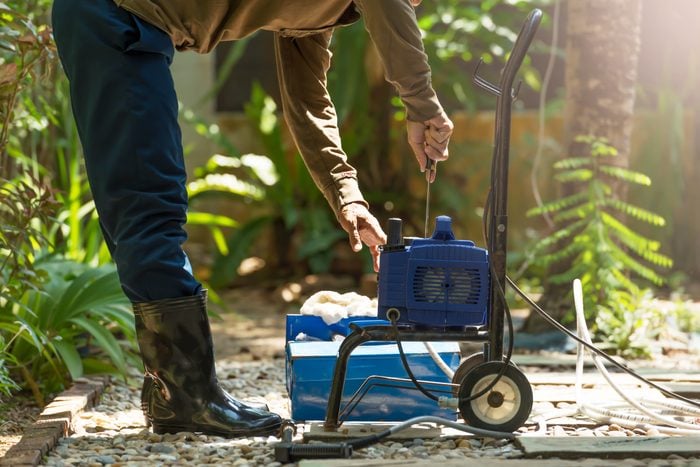How To Check, Clean and Replace Pressure Washer Filters
Updated: Jun. 06, 2023

When a pressure washer isn't performing well, clogged filters could be why. Learn how to find, clean or replace those filters.
Like many motorized machines, pressure washers rely on filters to work properly. The exact number depends on whether the unit is gas-powered or electric. Gas-powered models have two types of filters, and electric models have one.
Gas-powered washers have air and water inlet filters. Electric washers only have water inlet filters, because their lack of internal combustion makes air filters unnecessary.
Air filters keep dust, dirt and debris out of the engine’s carburetor so it runs smoothly. Water inlet filters stop waterborne dirt in your water supply hose from entering the pressure washer and disrupting the flow.
Both types can clog with dirt over time. With air filters, dirt limits the amount of air that makes it to your engine. When the clog is serious enough, your engine will noticeably lose power or even stall completely. Clogged water inlet filters lead to reduced water pressure.
If you notice either of these symptoms next time you run your pressure washer, start your troubleshooting with your filters.
On This Page
Signs Your Pressure Washer Filters Need Cleaning or Replacement
Luckily, your pressure washer will make it pretty obvious when there’s a problem with either kind of filter.
Air filters
Dust and debris are naturally drawn toward the engine as it runs. Air filters keep the bad stuff out.
This unwanted material builds up on the filter over time, gradually reducing airflow to the engine and eventually causing a drop in power. The engine will sound weaker, and your water pressure will probably be noticeably lower.
Water inlet filters
Pressure washer inlet filters are cylindrical fine-screen mesh, usually encased in a threaded brass fitting, found where the garden hose connects to your pressure washer. When enough dirt from your water supply collects in your inlet filter, water pressure will drop noticeably.
Tools and Supplies
Here’s what you’ll need to clean your pressure washer filters:
- Disposable shop towels;
- Air compressor with spray nozzle (optional);
- Water source;
- Dish soap;
- Small bucket;
- Fresh motor oil;
- Large zip-lock bag;
- Replacement air filter (if needed);
- Two adjustable wrenches;
- Old toothbrush.
How To Clean a Pressure Washer Filter
Air filter
- Locate the air filter cover, a rectangular plastic shroud near the gas tank and carburetor.
- Remove the cover by unthreading the nut holding it down or pulling the release tabs on the sides, depending on the model. Both are doable without tools.
- Locate the air filter. The style of filter varies by make and model. Inside the housing, you’ll find a simple rectangle of foam, a pleated paper rectangle or a pleated paper cylinder encased in a flexible foam cover. These are all air filters.
- Use an air compressor and spray nozzle to remove any loose debris from inside the housing, making sure to hold the air filter in place with one hand. If you don’t have an air compressor, wipe out the housing with a dry disposable shop towel.
- Remove and examine the air filter. If it’s visibly damaged, skip the cleaning and buy a replacement of the same type. If it’s a paper filter that’s really dirty, cleaning isn’t practical and you should also buy a replacement. Undamaged foam filters or the thin foam covers surrounding cylindrical filters can be cleaned.
- Clean your foam filter or foam cover by submerging and gently rubbing it in a bucket of warm, soapy water. Continue the rubbing until all signs of dirt and debris are gone.
- Rinse the filter with clean water to remove all soap residue.
- Squeeze as much water from the filter as possible, then let it dry fully.
Water inlet filter
- Locate the cylindrical water inlet filter fitting where your garden hose plugs into your pressure washer.
- Loosen and remove the fitting with an adjustable wrench. Depending on the style of inlet filter, you could remove the inner cylindrical screen filter by hand, or separate two halves of the fitting with your wrenches. It’s also possible your inlet filter screen is visible but not removable.
- Rinse the inner filter screen with water, gently scrubbing loose all visible dirt with an old toothbrush. Continue until the screen appears clean. Blow on one end as a final check to determine if air passes through easily. If the filter is clean, it should.
How To Replace a Pressure Washer Filter
Air filter
- Drizzle a tablespoon of fresh motor oil onto the clean foam filter if your machine uses this style. Then place the oiled filter into a clean zip-lock bag.
- Squeeze the filter through the bag to distribute the oil evenly.
- Remove the filter from the bag, then squeeze it against some clean shop towels to remove excess oil.
- Replace the cleaned filter in the housing, then put the filter cover back in place.
- For washers with a paper filter, buy a new filter the exact type as your old one, then reassemble your machine.
- For washers with cylindrical paper filters and foam covers, replace the inner filter if it’s dirty. Otherwise, wash the foam cover, then replace the filter in its housing and reinstall the cover.
Water inlet filter
- Place the inner screen filter back into its fitting.
- Thread and tighten the fitting back in place on your washer with your adjustable wrenches.
